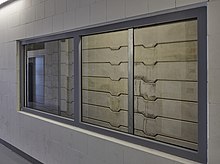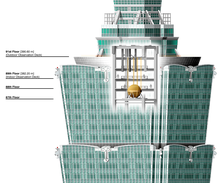Tuned mass damper
Mass dampers are frequently implemented with a frictional or hydraulic component that turns mechanical kinetic energy into heat, like an automotive shock absorber.
The system reportedly reduced lap times by 0.3 seconds: a phenomenal gain for a relatively simple device.
The usual design of damper on the crankshaft consists of a thin band of rubber between the hub of the pulley and the outer rim.
This device, often called a harmonic damper, is located on the other end of the crankshaft opposite of where the flywheel and the transmission are.
An alternative design is the centrifugal pendulum absorber which is used to reduce the internal combustion engine's torsional vibrations.
One use case for tuned mass dampers in bridges is to prevent large vibrations due to resonance with pedestrian loads.
[6] One proposal to reduce vibration on NASA's Ares solid fuel booster was to use 16 tuned mass dampers as part of a design strategy to reduce peak loads from 6g to 0.25g, with the TMDs being responsible for the reduction from 1g to 0.25g, the rest being done by conventional vibration isolators between the upper stages and the booster.
[7][8] High-tension lines often have small barbell-shaped Stockbridge dampers hanging from the wires to reduce the high-frequency, low-amplitude oscillation termed flutter.
The natural frequency of the tuned mass damper is basically defined by its spring constant and the damping ratio determined by the dashpot.
In a typical configuration, an auxiliary mass hung below the nacelle of a wind turbine supported by dampers or friction plates.
As mentioned above, damping devices had been used in the aeronautics and automobile industries long before they were standard in mitigating seismic damage to buildings.
Certain angles of wind and aerodynamic properties of a building can accentuate the movement and cause motion sickness in people.
However, during their lifetimes, high-rise and slender buildings may experience natural resonant frequency changes under wind speed, ambient temperature and relative humidity variations, among other factors, which requires a robust TMD design.









